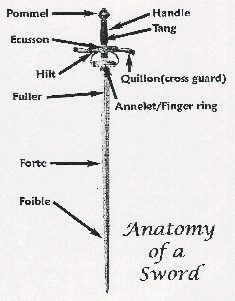|
|
|

|
|











|
Musters: Sword Work
When learning to use the sword, or any new weapon, the best rule of thumb is:
practice makes perfect. The guild uses practice swords called bokkens.
Bokkens are wooden swords used for sparring. These allow us to practice without
taking off a leg or severing any heads. ;)
The Anatomy of a Sword
Buying a SwordIf you plan on purchasing a sword, keep in mind what you intend to use it for and spend you funds accordingly. The following information is designed to help you make an informed buying decision. First, know what you want…Knowing what you want in a sword is half the battle. Know what kind of sword you want up front, rather than ordering catalogs to scan or searching through website after website to find one that appeals to you. Doing it this way will make you more selective in the ones that draw your attention. I recommend you take time to sit down and draw your ideal sword. Write down what kind of features you want it to have (see things to look for below.) Remember, there are marketers out there trying to lure you in. What they want to sell you isn't always what you need or want. My Armoury has a great sword comparison feature. Things to look for…Metallurgy- The science of steel and its properties. Do some research on types of steel. You will find that Stainless Steel, the type of steel that most Wall hanger swords are made of is a totally inappropriate steel for a sword. The sword made from Stainless Steel is molecularly brittle and will not stand up to the rigors of training or sparring- regardless of its country of origin. This type of steel is usually very high in chromium which acts as a grain enhancer but weakens the molecular bonds of a sword. Steels of different metallurgies have different properties, but they are all generally simple alloys or "low alloy" such as high carbon steel. Quality of Steel- Any serious buyer will ask the retailer how the sword was made. If the retailer is honest and wants to sell you a quality product -they will know this information. Part of this, is not only what type of steel was used, but where the steel was purchased from and how it was processed. Swords manufactured in third world countries, such as India, Philippines, and Pakistan, often use "spring steel." That is, steel made from recycled truck and tank springs. Recycling such steel takes skill and the "sword factories" of these countries are known for cutting corners. This can be a problem if the steel is not processed properly, resulting in the steel retaining its memory. The steel may stress and try to revert back to its original grain direction. It also may develop microcrystalline cracks, which after time and the stresses of use, causes "cracking" along the boundaries of the grain. In four words, the sword will break. Do not let this lead you to think that all recycled steel is bad. In fact, some of the best Japanese style swords have been forged from anything from welded cables to anchor irons. The difference is how the steel is recycled and processed for the sword. So talk to your retailer. Find out how the Sword Manufacturers/Smiths make their swords and where they get there steel. Ask how long they have been making swords and how often the retailer gets "returns" or has to ship back "damaged upon receipt" goods. If they really want to sell you the sword, they will answer or find out the information for you. Rockwell Hardness- This is a test for steel hardness. Rockwell hardness testing is an indentation testing method. An indenter is impressed into the steel sample at a prescribed load to measure the material's resistance to deformation. A Rockwell hardness number is calculated from the depth of permanent deformation of the sample after application and removal of the test load. Various indenter shapes and sizes combined with a range of test loads form a matrix of Rockwell hardness scales that are applicable to a wide variety of materials. Some manufacturers/smiths have this information on their products. They may not, but it is an excellent selling point if they do. The Rockwell modern steel hardness scale has a range of 20-80 points (on the Rockwell C scale). The higher the number, the harder and more brittle the steel is. Know the lingo…
Wall hanger- Name says it all folks. Leave this one on
the wall of the store, and if you do buy one...leave it on your wall.
Wall hangers are the most available type of sword. These are the swords
you see in the mall. They are not meant to be actually used for sword
training or even theatrical swordplay. They aren't safe for use and can
even be dangerous just swinging them around. Wall hangers are often made
with stainless steel, which is a metal much too brittle for use as a sword
blade. They are usually unbalanced, heavy, historically inaccurate, are
overly decorated, and (the most dangerous of all) they most always have
a "rat-tailed" tang. Don't let the price tag fool you either, these babies
can range from under $50 to over $1,000. Know your stuff and you can spot
a wall hanger in an instant!
Rat-tailed Tang- A Rat-tailed tang is a tang that does
not extend the full length of the handle. A full tang is preferred in
European swords, but a partial tang is best for Japanese swords. The point
where the tang thins is usually a high stress point. This can easily lead
to the tang snapping and either breaking through the handle or allowing
the blade to "fly" away from the hilt of the sword. Either situation is
very dangerous for everyone involved. Any sword with a Rat-tail tang
should be considered a wall hanger, even if the manufacturer or retailer
markets it as "battle-ready." Before you purchase your sword, ask the
retailer what kind of tang it has. Don't take it home without knowing
this information.
For more terms see the following links…
Credit to Paul LaRue and Swords & Medieval Collectibles
|
|
Site Design [ Zealina Glaw Lion ] Copyright [ 2002-2004 ] Last Updated [04/01/04] Visitor # [ 543 ] |
|